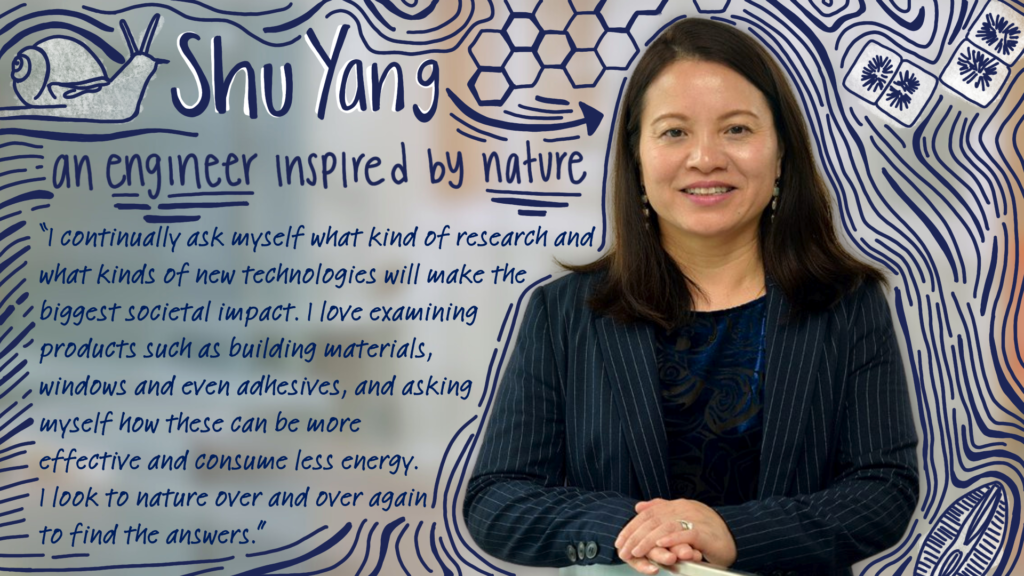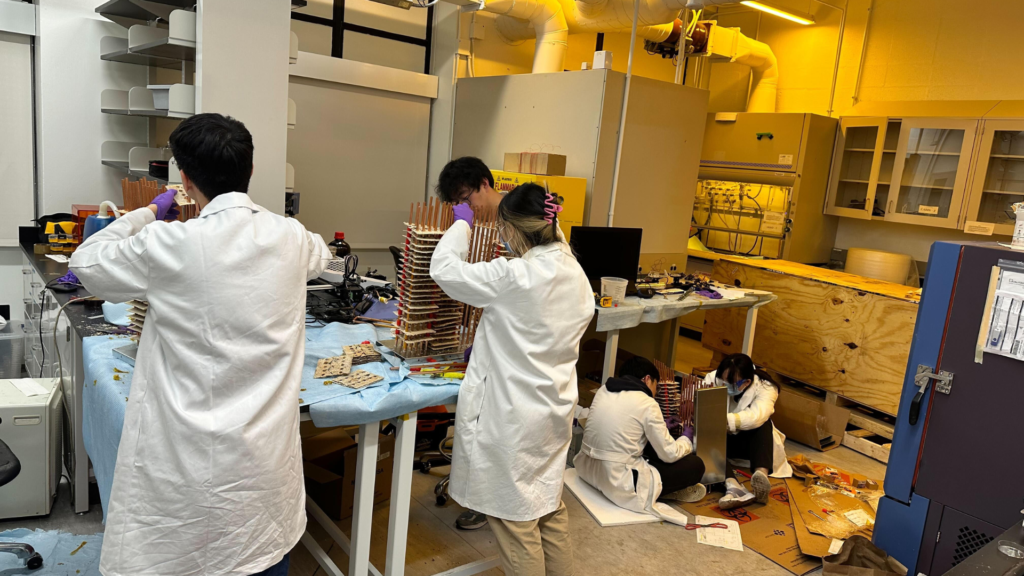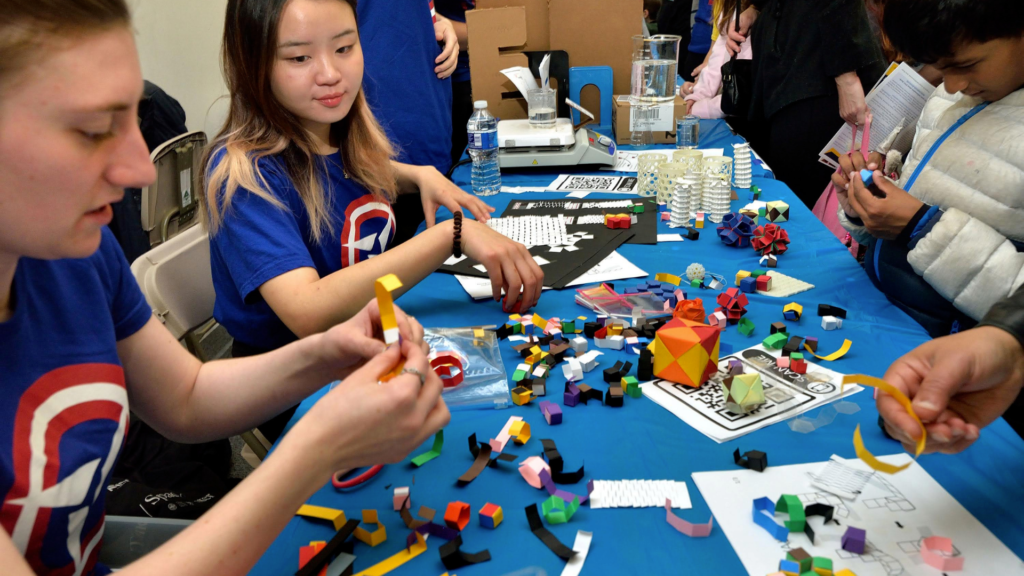
Original Article
Shu Yang, Joseph Bordogna Professor and Chair of Materials Science and Engineering, looks at her research through the lens of biomimicry: life forms and natural shapes have inspired her unique engineering solutions that span agriculture, building cooling and heating and reversible adhesives. For Yang, who also holds an appointment in Chemical and Biomolecular Engineering, each of her innovations start with changes on a fundamental level that can then grow into scalable and impactful products. Her creative approach, breadth of topics, and overwhelming number of applied inventions have named her this year’s Penn Center for Innovation Inventor of the Year.
“I continually ask myself what kind of research and what kinds of new technologies will make the biggest societal impact?” says Yang. “I love examining products such as construction materials, windows and even adhesives, and asking my group members how they can be more effective and consume less energy. I look to nature over and over again to find the answers.” Yang uses kirigami, the Asian art of cutting and folding materials that is similar to origami, to mimic nature’s link between structure and function in her own inventions. Just as the hexagonal shape of the cells in beehives keeps the entire structure cool without the need for an external energy source, one of Yang’s inventions, designed with kirigami techniques, pulls water from the air passively. “We created kirigami water collectors, sheets of plastic made up of unique, 3D pyramid structures,” says Yang. “The pyramid structures themselves trap air into vortices, like mini tornados. Moisture in the air in these tiny tornados is pulled onto the surface of the kirigami sheet with the help of a chemical coating that attracts water. The original device was made to provide fresh water from fog while dehumidifying large indoor and outdoor spaces, but it can be applied to a wide range of needs.”As part of a $2.2million, multi-university U.S. Department of Energy (DOE) project, Yang is redesigning these kirigami water collectors to be used in wood desiccation, a process required before wood can be burned to generate heat and power. The project will help the wood-drying industry to reach carbon-pollution-free electricity use by 2035.“The new design is a copper kirigami sheet coated with desiccant,” says Yang. “Recently, we needed to prepare 340 of these sheets. Once a sheet was made, it needed to be placed straight into the oven to keep it from sucking moisture from the air in the lab. That’s how immediately they work.” Students in Yang’s lab making the copper kirigami sheets organized a production assembly line to work quickly and efficiently as a teamAnother iteration of the desiccant will be used to make food drying more efficient in a multi-million dollar DOE project Yang and her colleagues were just awarded this past fall. “Food desiccation is important for food preservation, storage and transport,” says Yang. “The need to dry food efficiently will continue to grow as the population doubles and we face more severe food scarcity. We will need to keep food fresh for longer, transport it longer distances, and pack it into smaller spaces to conserve energy and resources.”While kirigami has taken center stage in the Yang lab, she continues to find new techniques to mimic natural structures in engineering. Funded by $4.6 million from the National Science Foundation (NSF) Eco Future Manufacturing Program (FMRG), Yang leads a team from Penn, Princeton University, Rowan and Rutgers University to develop self-morphing building blocks that can be assembled into human-scale structures, maximizing strength and minimizing weight in the same way evolution has optimized biological organisms such wood, chitin and bone at the cellular level. Additionally, Funded by $2.4 million from the DOE, Yang is working with Masoud Akbarzadeh, Assistant Professor of architecture in the Weitzman School of Design and director of the Polyhedral Structures Laboratory, to produce 3D-printed concrete with a porous design that allows for this building material itself to pull carbon dioxide out of the air.“Cement is the third largest industrial source of pollution,” says Yang. “Producing one ton of cement contributes over 1,300 pounds of carbon dioxide as well as the release of noxious gasses including sulfur dioxide, nitrogen oxide and carbon monoxide into the air. Our porous cement slab design conserves up to 60% of the material needed to make the structure and every 10 pounds of printed concrete structure has the potential to pull 0.9 pounds of carbon dioxide from the environment.”
Students in Yang’s lab making the copper kirigami sheets organized a production assembly line to work quickly and efficiently as a teamAnother iteration of the desiccant will be used to make food drying more efficient in a multi-million dollar DOE project Yang and her colleagues were just awarded this past fall. “Food desiccation is important for food preservation, storage and transport,” says Yang. “The need to dry food efficiently will continue to grow as the population doubles and we face more severe food scarcity. We will need to keep food fresh for longer, transport it longer distances, and pack it into smaller spaces to conserve energy and resources.”While kirigami has taken center stage in the Yang lab, she continues to find new techniques to mimic natural structures in engineering. Funded by $4.6 million from the National Science Foundation (NSF) Eco Future Manufacturing Program (FMRG), Yang leads a team from Penn, Princeton University, Rowan and Rutgers University to develop self-morphing building blocks that can be assembled into human-scale structures, maximizing strength and minimizing weight in the same way evolution has optimized biological organisms such wood, chitin and bone at the cellular level. Additionally, Funded by $2.4 million from the DOE, Yang is working with Masoud Akbarzadeh, Assistant Professor of architecture in the Weitzman School of Design and director of the Polyhedral Structures Laboratory, to produce 3D-printed concrete with a porous design that allows for this building material itself to pull carbon dioxide out of the air.“Cement is the third largest industrial source of pollution,” says Yang. “Producing one ton of cement contributes over 1,300 pounds of carbon dioxide as well as the release of noxious gasses including sulfur dioxide, nitrogen oxide and carbon monoxide into the air. Our porous cement slab design conserves up to 60% of the material needed to make the structure and every 10 pounds of printed concrete structure has the potential to pull 0.9 pounds of carbon dioxide from the environment.” The new, 3D-printed concrete will be able to pull carbon from the air due to its intricate, porous structure.“We are very excited about these new building materials because they are not only applicable for commercial buildings, but could also be used in low-income housing and post-disaster relief shelters,” says Yang. Yang’s creative inventions have also found their way into the medical space. From kirigami-inspired structures that aid in breast reconstruction to the manipulation of knots to create stronger sutures, Yang has brought simple yet effective technologies to impactful areas of research.“There are so many real-world applications for the kind of work I do,” says Yang. “I have been fortunate enough to work and ideate on projects spanning seed delivery inspired by the erodium plant, passive cooling systems inspired by the cracks in elephant skin, and food preservatives inspired by the white, waxy film on grapes. I am also looking at how to bring 3D-printing work into coral reef conservation and the design of living buildings, integrating vegetables, trees and bacteria into concrete.”Yang is grateful for the group of dedicated and open-minded students and postdocs in her lab that allow her to pursue such a diverse set of projects.
The new, 3D-printed concrete will be able to pull carbon from the air due to its intricate, porous structure.“We are very excited about these new building materials because they are not only applicable for commercial buildings, but could also be used in low-income housing and post-disaster relief shelters,” says Yang. Yang’s creative inventions have also found their way into the medical space. From kirigami-inspired structures that aid in breast reconstruction to the manipulation of knots to create stronger sutures, Yang has brought simple yet effective technologies to impactful areas of research.“There are so many real-world applications for the kind of work I do,” says Yang. “I have been fortunate enough to work and ideate on projects spanning seed delivery inspired by the erodium plant, passive cooling systems inspired by the cracks in elephant skin, and food preservatives inspired by the white, waxy film on grapes. I am also looking at how to bring 3D-printing work into coral reef conservation and the design of living buildings, integrating vegetables, trees and bacteria into concrete.”Yang is grateful for the group of dedicated and open-minded students and postdocs in her lab that allow her to pursue such a diverse set of projects. Students in Yang’s lab communicate their research in material science and chemistry through demonstrations at Philly Materials Day.“I like to mentor students with broader views in research and hope they will grow diverse viewpoints of the world and see how they can make their shares of impact,” says Yang. “There are over 20 students and postdocs in my lab, and each of them is dedicated to the communication of the importance of our work as well. As a team, we have been involved in community science demonstration events such as the Philly Materials Day, NanoDay and Science Cafe to widen the reach of our work and make science, technology, engineering and mathematics (STEM) more accessible to younger generations.”Soon, Yang’s inventions will be tackling real-world problems from wood desiccation to sustainable building materials. She plans to communicate her work supported by the DOE at conferences and community engagement events to not only solve problems with her own devices, but inspire others to make their own.
Students in Yang’s lab communicate their research in material science and chemistry through demonstrations at Philly Materials Day.“I like to mentor students with broader views in research and hope they will grow diverse viewpoints of the world and see how they can make their shares of impact,” says Yang. “There are over 20 students and postdocs in my lab, and each of them is dedicated to the communication of the importance of our work as well. As a team, we have been involved in community science demonstration events such as the Philly Materials Day, NanoDay and Science Cafe to widen the reach of our work and make science, technology, engineering and mathematics (STEM) more accessible to younger generations.”Soon, Yang’s inventions will be tackling real-world problems from wood desiccation to sustainable building materials. She plans to communicate her work supported by the DOE at conferences and community engagement events to not only solve problems with her own devices, but inspire others to make their own.




